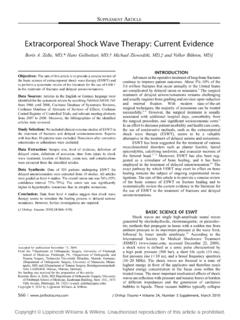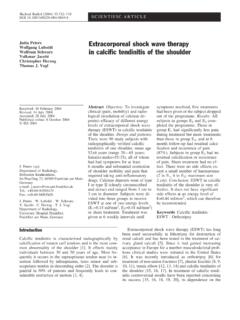Transcription of Technological Differences in Energy Wave & Focal …
1 shockwave therapy Technological Differences in Energy Wave & Focal Zone characteristics between modalities First Use in Medicine Kidney stone lithotripsy Mid 70 s Advent of minimally invasive medical technology. 10yr follow-up on patients found changes in: MSK & Bone density. Considered for use in orthopaedic application (Herr, 2008) Type of Devices Technology Used in Lithotripsy Electro-Hydraulic MediSpec Dornier Electro-Magnetic Siemens Storz NOTE: Radial pulse is not used in lithotripsy Piezo-electric poor efficacy Not used shockwave characteristics A Shock Wave = A high-pressure amplitude with the following typical characteristics .
2 Sharp impulse with pulse width of 1us (equivalent to 1 MHz) Rise time of approximately 40 nano seconds Peak pressure higher than 50 Bars (Gerdesmeyer et al, 2004) shockwave Cavitation Only True shockwave system generates cavitation, penetrating deeper to the treated area, yielding higher efficacy and better clinical results. (Weschel, 2004) Cavitation bubbles occur directly after the pressure/tension alternating load of the shockwaves has passed in a water medium. Shock wave therapy causes fragmentation of calcium deposits into crumb and circulation slowly clears the site.
3 (Gerdesmeyer, 2005, Craig & Miller 2011) Note: Radial & piezoelectic devices CANNOT produce cavitation as it does not have a liquid medium Mechanism of Action: ESWT ESWT onto Injury Site Anti-inflammatory Response, Improved Micro-circulation, modulation of neurotransmitters & immune response Increased Cellular Permeability & Neuronal Signalling. Release of eNOS Cellular Expression of Growth Factors PCNA, VEGF. Collagen Type 1, Progenitor cells Generation. New Vascularisation & Injury Resolution Schaden, 2001; Ogden, 2002; Weil et al, 2002; Ogden et al.
4 , 2004; Furia, 2006; Amelio & Manganotti, 2010; Angehrn,2008; Cacchio, et al, 2009; Furia, 2008; Mariotto, 2005;Mariotto, 2009 Nortanicola et al., 2010 shockwave vs Radial Pulse therapy ESWT RWT Penetration Depth 0-140 mm 0-35 mm Pressure of Wave Relative To Time Diagram of Pressure Wave Within Tissue Pressure Time Pressure Time The Radial device (RWT) ie. dolorclast is a cheap alternative and is NOT a shockwave device. Important Factors for shockwave Generation Size of Focal / therapy zone. Effects: Number of shocks required per Tx.
5 Region / area covered during each Tx. Impacts of Tx outcomes Electrode spacing gap (optimum gap ) Provides a uniform wave Bio-physiological impact on tissue Impacts Tx outcomes The Device(S) We Use OrthoSpec OR 3 OrthoSpec OR5 All devices are manufactured by MediSpec Ltd. Small vs. Large Focus Zone Energy level up to Relatively even Energy distribution throughout the therapy Zone Does not require imaging (X-Ray or ultrasound) or anesthesia Typical size at -6dB: Diameter 3mm Height 30mm ED = mj / mm 2 Size at -6 dB: Diameter 26mm Height 96 mm ED = mj / mm 2 Size at 5 MPa therapy Zone.
6 Diameter 46mm Height 134 mm ED = mj / mm 2 Typical *ESWT System Small Focus Zone Orthospec Large therapy Zone Imaging (X-Ray or ultrasound) and anesthesia are recommended ED = mj / mm 2 Typical size at 5 MPa: Diameter 7mm Height 35mm * Data provided to ISMST by various companies OrthoSpec vs Other Devices OrthoSpec Special Patents: 1 Allows for large Focal therapeutic region due to unique reflector design combining and elliptical and ellipsoidal reflector OrthoSpec Special Patents: 2 The Orthospec patented reflector uses both focused and unfocussed wave, resulting in better clinical efficiency Penetration Depth: OrthoSpec vs Radial CT Scan of gluteus mimimus region: penetration of focused ESWT (125mm) vs radial (dolorclast 30mm) This is why we chose the OrthoSpec Electro-hydraulic device after 18 months of testing all other devices.
7 Better long term clinical outcomes and versatility. ESWT in New Zealand In 2000 Mr. Bruce Twaddle & I commenced investigation of shockwave devices. Devices tested: Reflectron (electro-magnetic) HMT Dolorclast (pneumatic-radial) EMS OrthoSpec OR3 (electro-hydraulic) MediSpec In 2002 Mr. Joe Brownlee investigated ESWT using Piezosone 100 (piezo-electric) - Wolf Conclusion November 2002 the OrthoSpec was selected because of its superior Tx outcomes compared to the other devices. This is constant with international findings.
8 Expertise and leadership of the manufacturer MediSpec in medical shockwave technology. Mr. Brownlee s concluded that the piezo-electric device was ineffective, and did not proceed with it. This is constant with international findings. Expansion of the Use of ESWT in Medicine Advances in shockwave Medicine Cardiology (Vasyuk et al., 2010) Complex Ulcers (Schaden et al., 2007; Sagginni et al, 2008; Moretti et al., 2009; Mittermyer et al, 2011) Erectile dysfunction (Yardi et al., 2010; Yardi et al., 2012; Gruenwald et al, 2012) Dystonia (Trompetto et al, 2009; Amelio et al.)
9 , 2010) Neuropathy (Craig K & Walker M, 2012; Craig et al, 2011) Complex Pain (Nortanicola et al., 2009; Craig, 2011; D Agostino et al, 2011; Craig K, D agostino, & Perez R., 2012) Note: Radial & piezoelectric devices are NOT used in these areas. Electrohydraulic Devices Across Disciplines E3000 & EM1000 Extracorporeal Shock wave lithotripters UROLOGY Cardiospec SWT for cardiac ischemic diseases CARDIOLOGY Orthospec Orthopedic Shock wave system ORTHOPEDICS ED1000 SWT for erectile dysfunction VASCULAR Reference Herr H.
10 (2008). Crushing the Stone : a brief history of lithotripsy, the first minimally invasive surgery. British Journal of Urology International, 102(4) 432 - 435. Schaden, W., Fisher, A. & Sailler, A. (2001). Extracorporeal shockwave therapy of Nonunion or Delayed Osseous Union. Clinical Orthopaedics and Related Research, 387; 90 94. Ogden, J. A., Alvarez, R. G. & Marlow, M. E. (2002). shockwave therapy for Chronic Proximal Plantar Fasciitis: A Meta Analysis. Foot and Ankle International 23 (4) 301 308. Ogden, J.

